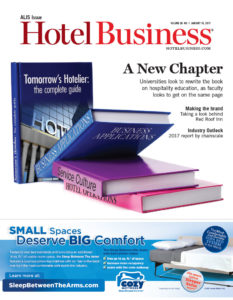The upper-midscale hotel segment has been one of the fastest-growing chainscales in recent years, and some wonder how much longer the segment can continue to thrive given the new supply. Among insiders, the 2017 outlook for the sector remains mixed.
On one hand, some fear occupancy will slide noticeably this year as new inventory comes online and demand softens. Others, meanwhile, see the segment sustaining occupancy again this year at healthy, near-2016 levels, while continuing to drive rate and RevPAR. It all depends on who you ask and which market you’re discussing.
“We expect the select-service upper-midscale segment to continue to outperform as a result of the relationship of demand to supply in many markets we target, consumer preferences and a generation of travelers that prefer sleek, modern and efficient hotels,” said Bill Blackham, president and CEO of Condor Hospitality Trust. “We expect RevPAR in this segment will outpace all other segments, and the national average, substantially through the opportunity to drive rate as a result of attractive occupancy levels.”
Blackham’s sentiments are mirrored by some of the prevailing research forecasts, predominantly the latest consensus from CBRE Hotels’ Americas Research, which is expecting a minimal drop in occupancy of just -0.1% to 67.3% overall in 2017, compared to an ADR gain of 3.3% to $115.37 and RevPAR growth of 3.2%, to $77.61. CBRE Hotels’ Americas Research year-end 2017 ADR and RevPAR projections for upper-midscale are the highest of the seven segments it tracks.
Others, however, are somewhat more conservative in their outlook. STR is projecting a year-end 2017 upper-midscale occupancy decline of -1.0%—the second highest decline of the seven segments, behind upscale—plus lukewarm ADR growth of 2.3%, and a comparatively underwhelming RevPAR increase of 1.3%. The thinking is that new supply, which CBRE Hotels’ Americas Research estimates at 2.8% growth versus a 2.7% uptick in demand, paired with the significant amount of upper-midscale product that’s already been opening in recent years, will make competing in the chainscale more difficult than some anticipate.
“Just the fact that you’ve got a lot of new rooms out there that are still going to come online, that’s going to be a challenge, and that’s why, when you look at the forecast we have, upscale and upper-midscale are forecast to be down in occupancy more than anyone else,” said Bobby Bowers, SVP of operations for STR. “That’s just because that’s where most of the supply is—not as far as the absolute numbers, but in terms of the base of the supply they have compared to new construction. That percentage is really high.”
The new supply of recent years may also create tight future competition for labor in both the upper-midscale and upscale segments, according to sources. In general, the hotel industry has been feeling the sting of rising labor costs and a more competitive job market, now that unemployment rates are on the wane. In some saturated markets, finding good, affordable help could become a serious issue.
“I do think another influencing factor is the competition for labor in those areas where there’s supply growth. All those hotels need new employees,” said R. Mark Woodworth, senior managing director, head of lodging research, CBRE Hotels’ Americas Research. “That’s an extra level of pressure those managers are feeling, because that new competitor across the street is not only going to want to steal your customers, but also your employees. You might make an argument that this issue is a little more acute in the middle of the pile, where we’re seeing all the supply growth: in the upper-midscale and upscale categories.”
Still, proponents remain cautiously optimistic about upper-midscale’s prospects in 2017, stating there are some oversaturated markets to be sure, however there may be continued growth potential in others. Some say that potential, paired with the pervasive popularity of upper-midscale brands, bodes well for the chainscale again this year.
“I’m a believer in the segment, and I believe that to some degree, upper-midscale is a little bit insulated from the ebbs and flows of the economy, just because it’s so well positioned,” said Bob Habeeb, president and CEO of First Hospitality Group (FHG). “There’s a good brand story there, which is the leading brands are the bellwethers of the industry. Consumers love them. The question becomes: Because everybody loves that segment and companies are developing new brands in every niche, at some point do you kill the proverbial goose that laid the golden egg? I don’t see any sign of it, but you certainly have to fear that.”

